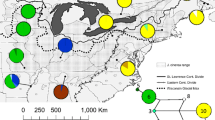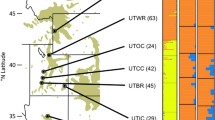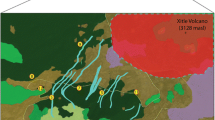Abstract
Contrasting signals of genetic divergence due to historic and contemporary gene flow were inferred for Coachwood, Ceratopetalum apetalum (Cunoniaceae), a wind-dispersed canopy tree endemic to eastern Australian warm temperate rainforest. Analysis of nine nuclear microsatellites across 22 localities revealed two clusters between northern and southern regions and with vicariance centred on the wide Hunter River Valley. Within populations diversity was high indicating a relatively high level of pollen dispersal among populations. Genetic variation was correlated to differences in regional biogeography and ecology corresponding to IBRA regions, primary factors being soil type and rainfall. Eleven haplotypes were identified by chloroplast microsatellite analysis from the same 22 localities. A lack of chloroplast diversity within sites demonstrates limited gene flow via seed dispersal. Network representation indicated regional sharing of haplotypes indicative of multiple Pleistocene refugia as well as deep divergences between regional elements of present populations. Chloroplast differentiation between sites in the upper and lower sections of the northern population is reflective of historic vicariance at the Clarence River Corridor. There was no simple vicariance explanation for the distribution of the divergent southern chlorotype, but its distribution may be explained by the effects of drift from a larger initial gene pool. Both the Hunter and Clarence River Valleys represent significant dry breaks within the species range, consistent with this species being rainfall dependent rather than cold-adapted.



Similar content being viewed by others
References
Adam P (1992) Australian rainforests. Oxford University Press, Oxford
Angelone S, Hilfiker K, Holderegger R, Bergamini A, Hoebee SE (2007) Regional population dynamics define the local genetic structure in Sorbus torminalis. Mol Ecol 16:1291–1301
Barnes RW, Hill RS (1999) Ceratopetalum fruits from Australian Cainozoic sediments and their significance for petal evolution in the genus. Aust Syst Bot 12:635–645
Baur GN (1957) Nature and distribution of rainforests in New South Wales. Aust J Bot 5:190–233
Black MP, Mooney SD, Martin HA (2006) A>43000-year vegetation and fire history from Lake Baraba, New South Wales, Australia. Quat Sci Rev 25:3003–3016
Bond WJ, Midgley JJ (2001) Ecology of sprouting in woody plants: the persistence niche. Trends Ecol Evol 16:45–51
Bowman DMJS (2000) Australian rainforests—Islands of green in a land of fire. Cambridge University Press, Cambridge, UK
Crawford NG (2010) SMOGD: software for the measurement of genetic diversity. Mol Ecol Resour 10:556–557
Di Virgilio G, Laffan SW, Ebach MC (2012) Fine-scale quantification of floral and faunal breaks and their geographic correlates, with an example from south-eastern Australia. J Biogeogr 39:1862–1876
Ennos RA (1994) Estimating the relative rates of pollen and seed migration among plant-populations. Hered 72:250–259
Evanno G, Roegnaut S, Goudet J (2005) Detecting the number of clusters of individuals using the software STRUCTURE: a simulation study. Mol Ecol 14:2611–2620
Floyd AG (1990) Australian rainforests in New South Wales. Surrey Beatty, Sydney
Ford J (1987) Minor isolates and minor geographical barriers in avian speciation in continental Australia. EMU 87:90–102
Goudet J (1995) FSTAT (Version 1.2): a computer program to calculate F-statistics. J Hered 86:485–486
Heslewood MM, Porter C, Avino M, Rossetto M (2009) Isolation and characterization of nuclear microsatellite loci from Ceratopetalum apetalum (Cunoniaceae). Mol Ecol Resour 9:566–568
Heuertz M, Fineschi S, Anzidei M et al (2004) Chloroplast DNA variation and postglacial recolonization of common ash (Fraxinus excelsior L.) in Europe. Mol Ecol 13:3437–3452
Heuertz M, Carnevale S, Fineschi S et al (2006) Chloroplast DNA phylogeography of European ashes, Fraxinus sp (Oleaceae): roles of hybridization and life history traits. Mol Ecol 15:2131–2140
Hewitt GM (2004) Genetic consequences of climatic oscillations in the Quaternary. Phil Trans R Soc B 359:183–195
Hilbert DW, Graham A, Hopkins MS (2007) Glacial and interglacial refugia within a long-term rainforest refugium: the wet tropics bioregion of NE Queensland, Australia. Palaeogeogr Palaeoclim Palaeoecol 251:104–118
Hill RS, Truswell EM, McLoughlin S, Dettmann ME (1999) The evolution of the Australian flora: fossil evidence. In: Orchard AE (ed) Flora of Australia, vol 1., IntroductionCSIRO Publishing, Melbourne, pp 251–320
Hoogland RD (1960) Studies in the Cunoniaceae. I. The genera Ceratopetalum, Gillbeea, Aistopetalum, and Calycomis. Aust J Bot 8:318–341
Hoogland RD (1981) Studies in the Cunoniaceae III. Additional notes on Ceratopetalum and Acrophyllum. Brunonia 4:213–216
Hopkins MS, Ash J, Graham AW, Head J, Hewett RK (1993) Charcoal evidence of the spatial extent of the Eucalyptus woodland expansions and rainforest contractions in north Queensland during the late Pleistocene. J Biogeogr 20:357–372
Jordano P (2010) Pollen, seeds and genes: the movement ecology of plants. Hered 105:329–330
Joseph L, Dolman G, Donnellan S et al (2008) Where and when does a ring start and end? Testing the ring-species hypothesis in a species complex of Australian parrots. Proc Trans R Soc B 275:2431–2440
Jost LOU (2008) GST and its relatives do not measure differentiation. Mol Ecol 17:4015–4026
Kershaw AP, Bretherton SC, van der Kaars S (2007) A complete pollen record of the last 230 ka from Lynch’s Crater, north-eastem Australia. Palaeogeogr Palaeoclim Palaeoecol 251:23–45
Kooyman R, Rossetto M, Cornwell W, Westoby M (2011) Phylogenetic tests of community assembly across regional to continental scales in tropical and subtropical rain forests. Global Ecol Biogeogr 20:707–716
Magri D, Vendramin GG, Comps B et al (2006) A new scenario for the Quaternary history of European beech populations: palaeobotanical evidence and genetic consequences. New Phytol 171:199–221
McLoughlin S (2001) The breakup history of Gondwana and its impact on pre-Cenozoic floristic provincialism. Aust J Bot 49:271–300
Mellick R, Lowe A, Rossetto M (2011) Consequences of long- and short-term fragmentation on the genetic diversity and differentiation of a late successional rainforest conifer. Aust J Bot 59:351–362
Milner ML, Rossetto M, Crisp MD, Weston PH (2012) The impact of multiple biogeographic barriers and hybridization on species-level differentiation. Am J Bot 99:2045–2057
Nicholls JA, Austin JJ (2005) Phylogeography of an east Australian wet-forest bird, the satin bowerbird (Ptilonorhynchus violaceus), derived from mtDNA, and its relationship to morphology. Mol Ecol 14:1485–1496
Oddou-Muratorio S, Petit RJ, Le Guerroue B, Guesnet D, Demesure B (2001) Pollen-versus seed-mediated gene flow in a scattered forest tree species. Evolution 55:1123–1135
Pakkad G, Ueno S, Yoshimaru H (2008) Genetic diversity and differentiation of Quercus semiserrata Roxb. in northern Thailand revealed by nuclear and chloroplast microsatellite markers. For Ecol Manag 255:1067–1077
Peakall R, Smouse PE (2006) GENALEX 6: genetic analysis in Excel. Population genetic software for teaching and research. Mol Ecol Notes 6:288–295
Petit RJ, Duminil J, Fineschi S et al (2005) Comparative organization of chloroplast, mitochondrial and nuclear diversity in plant populations. Mol Ecol 14:689–701
Playford J, Bell JC, Moran GF (1993) A major disjunction in genetic diversity over the geographic range of Acacia melanoxylon R.Br. Aust J Bot 41:355–368
Pons O, Petit RJ (1996) Measuring and testing genetic differentiation with ordered versus unordered alleles. Genetics 144:1237–1245
Pritchard JK, Stephens M, Donnelly P (2000) Inference of population structure using multilocus genotype data. Genetics 155:945–959
Rice WR (1989) Analyzing tables of statistical tests. Evolution 43:223–225
Rossetto M, Kooyman RM (2005) The tension between dispersal and persistence regulates the current distribution of rare palaeo-endemic rain forest flora: a case study. J Ecol 93:906–917
Rossetto M, Gross CL, Jones R, Hunter J (2004a) The impact of clonality on an endangered tree (Elaeocarpus williamsianus) in a fragmented rainforest. Biol Conserv 117:33–39
Rossetto M, Jones R, Hunter J (2004b) Genetic effects of rainforest fragmentation in an early successional tree (Elaeocarpus grandis). Hered 93:610–618
Rossetto M, Crayn D, Ford A, Ridgeway P, Rymer P (2007) The comparative study of range-wide genetic structure across related, co-distributed rainforest trees reveals contrasting evolutionary histories. Aust J Bot 55:416–424
Rossetto M, Kooyman R, Sherwin W, Jones R (2008) Dispersal limitations, rather than bottlenecks or habitat specificity, can restrict the distribution of rare and endemic rainforest trees. Am J Bot 95:321–329
Rossetto M, Crayn D, Ford A, Mellick R, Sommerville K (2009) The influence of environment and life-history traits on the distribution of genes and individuals: a comparative study of 11 rainforest trees. Mol Ecol 18:1422–1438
Rossetto M, Allen C, Thurlby K, Weston P, Milner M (2012) Genetic structure and bio-climatic modeling support allopatric over parapatric speciation along a latitudinal gradient. BMC Evol Biol 12:149
Rousset F (2008) GENEPOP ‘ 007: a complete re-implementation of the GENEPOP software for Windows and Linux. Mol Ecol Resour 8:103–106
Rozefelds AC, Barnes RW (2002) The systematic and biogeographical relationships of Ceratopetalum (Cunoniaceae) in Australia and New Guinea. Int J Plant Sci 163:651–673
Schodde R, Mason IJ (1997) Psittacidae. In: WWK Houston, Wells A (eds) Aves (Columbidae to Coraciidae). Zoological Catalogue of Australia Vol. 37.2. CSIRO Publishing, Melbourne, pp 109-218. Taylor KJ, Lowe AJ, Hunter RJ et al (2005) Genetic diversity and regional identity in the Australian remnant Nothofagus moorei. Aust J Bot 53:437–444
Tulau MJ (1999) Acid sulfate soil management priority areas in the Lower Clarence floodplain (Report). Department of Land and Water Conservation, Sydney
van Oosterhout C, Weetman D, Hutchinson WF (2006) Estimation and adjustment of microsatellite null alleles in nonequilibrium populations. Mol Ecol Notes 6:255–256
Webb LJ, Tracey JG (1981) Australian rainforests: patterns and change. In: Keast A (ed) Ecological Biogeography of Australia. W. Junk, The Hague, pp 605–694
Weising K, Gardner RC (1999) A set of conserved PCR primers for the analysis of simple sequence repeat polymorphisms in chloroplast genomes of dicotyledonous angiosperms. Genome 42:9–19
Williams NJ, Harle KJ, Gale SJ, Heijnis H (2006) The vegetation history of the last glacial–interglacial cycle in eastern New South Wales. J Quat Sci 21:735–750
Worth JRP, Jordan GJ, McKinnon GE, Vaillancourt RE (2009) The major Australian cool temperate rainforest tree Nothofagus cunninghamii withstood Pleistocene glacial aridity within multiple regions: evidence from the chloroplast. New Phytol 182:519–532
Worth JRP, Jordan GJ, Marthick JR, McKinnon GE, Vaillancourt RE (2010) Chloroplast evidence for geographic stasis of the Australian bird-dispersed shrub Tasmannia lanceolata (Winteraceae). Mol Ecol 19:2949–2963
Acknowledgments
We thank Steve Clarke, Maria Cotter, Robert Kooyman, Hannah McPherson, Louisa Murray, Carolyn Connelly, Marlien van der Merwe, Peter Weston and Michael Whitehead for assisting with fieldwork or supplying specimens. We thank Chris Togher, Chris Allen and Rohan Mellick for assistance with the GIS and the map. The project was funded by the Australian Research Council (DP0665859).
Author information
Authors and Affiliations
Corresponding author
Rights and permissions
About this article
Cite this article
Heslewood, M.M., Lowe, A.J., Crayn, D.M. et al. Contrasting levels of connectivity and localised persistence characterise the latitudinal distribution of a wind-dispersed rainforest canopy tree. Genetica 142, 251–264 (2014). https://doi.org/10.1007/s10709-014-9771-8
Received:
Accepted:
Published:
Issue Date:
DOI: https://doi.org/10.1007/s10709-014-9771-8




